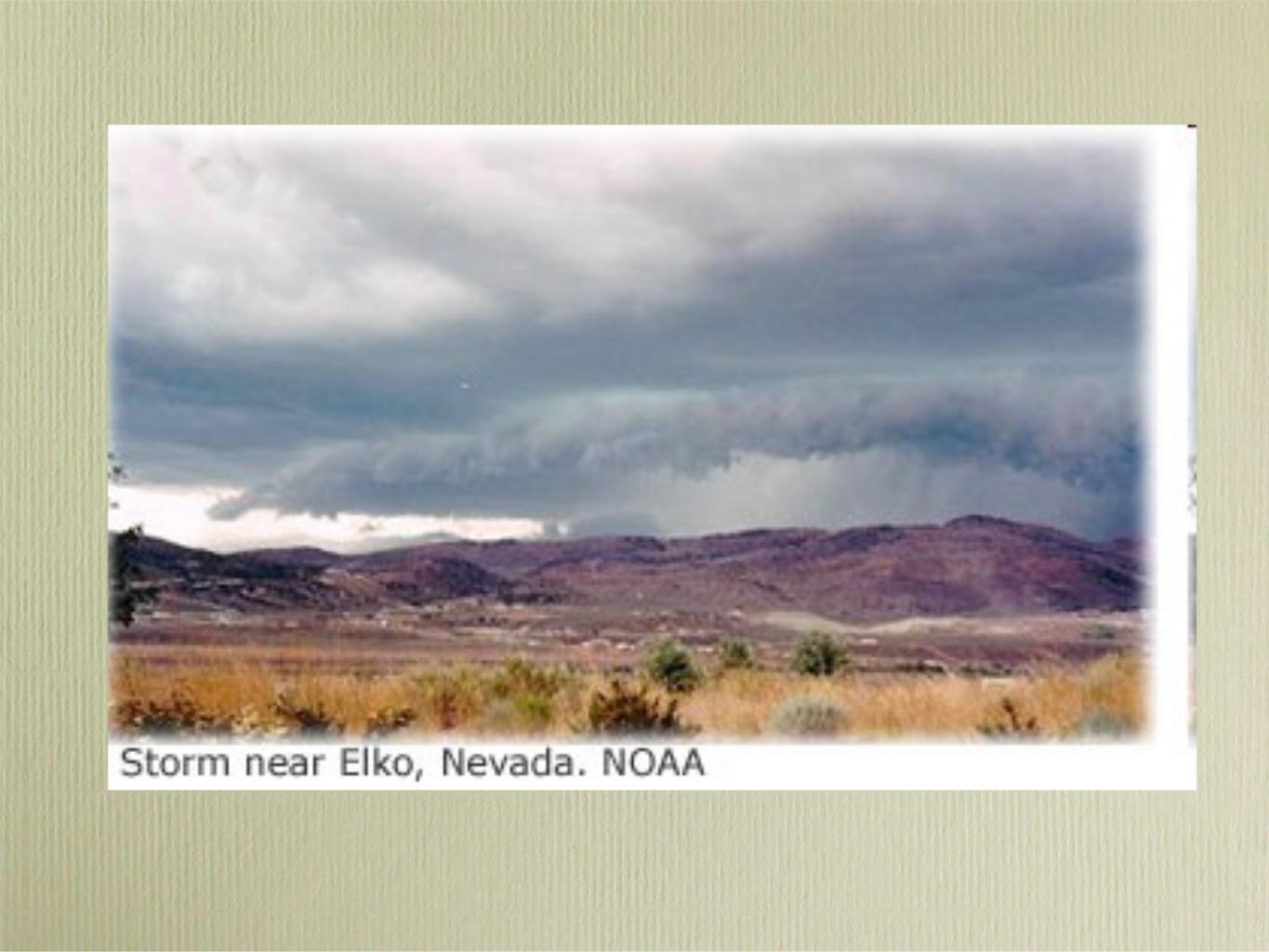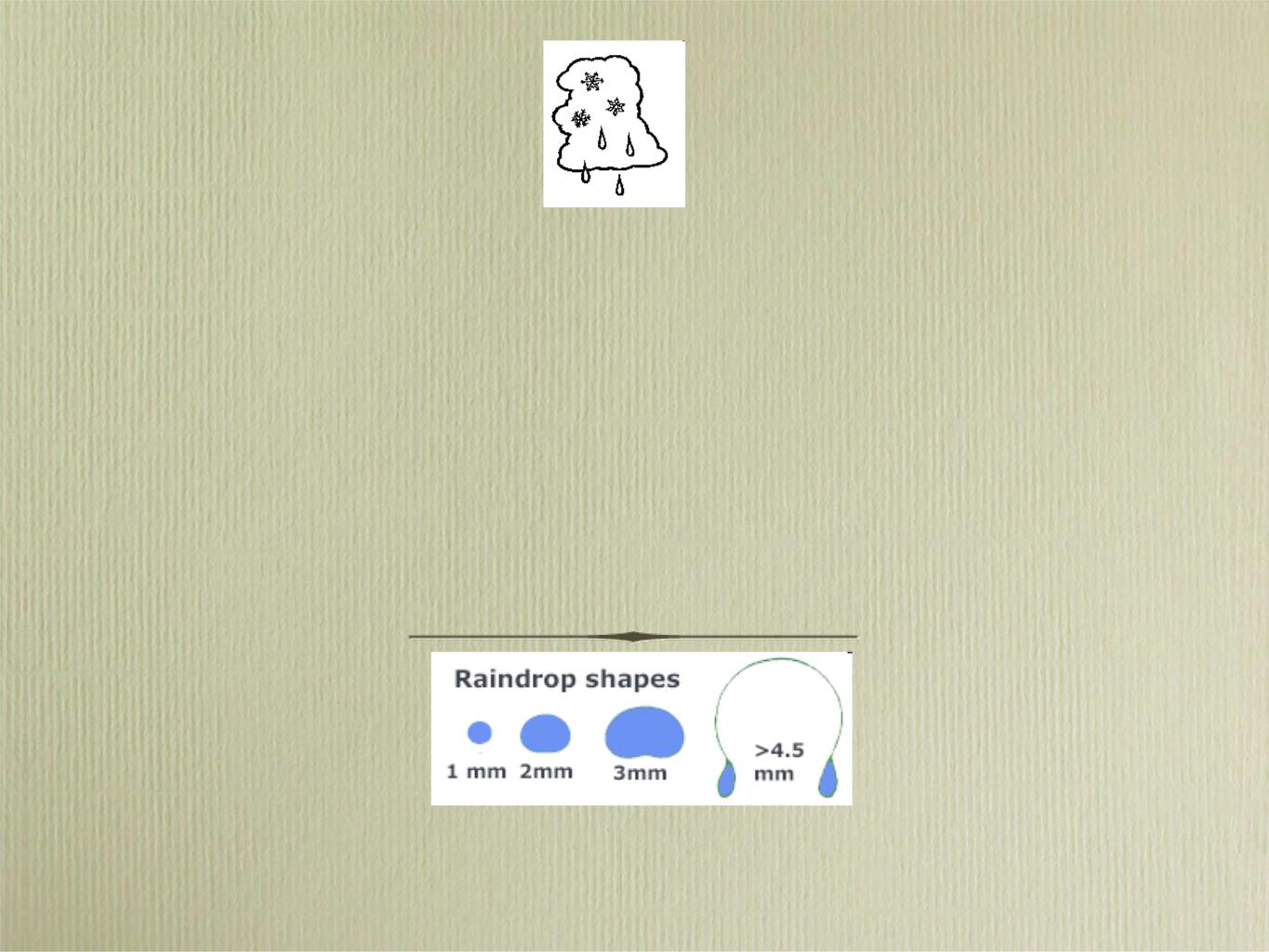
- •Fast questionnaire
- •Definition
- •Hydrometeor
- •The amount of Precipitation falling out per a unit of time is called
- •Rain, snow, or ice pellets may fall steadily or in showers. Steady precipitation
- •All precipitation types are called hydrometeors, of which additional forms are clouds, fog,
- •Can you guess the shape of raindrops?
- •http://www.wxdude.com/page3.html
- •thicknes
- •Precipitation rates vary geographically and over time
- •Virga
- •Virga
- •Virga
- •Virga
- •Processes of cloud element enlargement and precipitation formation
- •Coagulation
- •Precipitation from stratiform clouds.
- •The rate of fall for solid and liquid particles in the atmosphere
- •According to Stocks law for ball like particles
- •dimensionless number, gives a measure of the ratio of inertial forces to viscous
- •Ball-like particle fall under influence of gravity, small Re
- •Owing to the fact that F and G are directed along vertical line,
- •Unsteady motion dV/dt ≠ 0

Fast questionnaire
Version 1
1.Give the definition of the solar constant?
2.Write the dimension of the eddy coefficient, please.
3.Write down the humid air state equation and give notions to all terms.
4.What does convection process mean?
5.Write down statics’ equation and give notions to all terms.
6.What is the potential temperature?
Version 2
1.What value is higher and why: meteorological or astronomical solar constant?
2.Please, describe the entrainment process briefly.
3.Write down the dry air state equation and give notions to all terms.
4.How do you understand term “convergence”?
5.Please, give numerical form of relation between dry air gaseous constant R and specific heats at const V and p.
6.Write down the potential temperature formula with all notations.


Definition
Water drops and ice crystals falling out or
any product of the condensation of atmospheric water vapor that is pulled down by gravity and deposited on the Earth's surface
is called
Precipitation.
Amount of precipitation is measured by
the thickness of the liquid water layer that could be formed after precipitation fall out on a horizontal surface.
1 mm= 1 kg/m2

Hydrometeor
The term meteor describes an object from outer space which has entered the Earth's atmosphere and produces a light phenomenon

The amount of Precipitation falling out per a unit of time is called
Precipitation intensity
mm/s (rare), mm/h (forecasts), mm/day,
mm/ month (climatologically texts)
Forms of
Precipitation:
•rain,
•snow,
•ice pellets (шарик,гранула),
•graupel
•dew
•drizzle (r< 0.25 mm)
•sleet

Dew
Liquid drops formed on the surfaces after water vapor condensation against chilled surfaces.
Example:
Over thin blades of grass and leaves at night
In England sleet is defined as a mixture of rain and snow, or melting snow.

Rain, snow, or ice pellets may fall steadily or in showers. Steady precipitation may be intermittent (перемежающийся) though lacking sudden bursts of intensity.
Hail, small hail, and snow pellets occur only in showers.
Drizzle, snow grains, and ice crystals occur as steady precipitation.
Showers originate from instability clouds of the cumulus family, whereas
steady precipitation originates from stratiform clouds.

All precipitation types are called hydrometeors, of which additional forms are clouds, fog, wet haze, mist, blowing snow, and spray. Whenever rain or drizzle freezes on contact with the ground to form a solid coating of ice, it is called
•freezing rain,
•freezing drizzle,
•or glazed frost;
•it is also called an ice storm or a glaze storm, and sometimes is popularly known as
• silver thaw (оттепель) or
•erroneously (ошибочно) as a sleet storm.

|
|
Duration of precipitation |
•Brief |
-Short duration. |
|
•Intermittent |
-Precipitation which ceases at times. |
|
•Occasional |
-Precipitation which while not frequent, is recurrent. |
|
•Frequent |
-Showers occurring regularly and often. |
|
•Continuous |
-Precipitation which does not cease, or ceases only |
|
briefly. |
|
-Rain is expected to fall most of the times, but there |
•Periods of rain |
||
will be breaks. |
|
|
|
|
Distribution of showers and precipitation |
•Few- |
Indicating timing and not area. |
|
•Isolated |
-Showers which are well separated in space during a given |
|
period. |
-Restricted to relatively small areas. |
|
•Local |
||
•Patchy- |
Occurring irregularly distributed over an area. |
|
•Scattered -Irregularly distributed over an area. Showers, which while |
||
not widespread, can occur anywhere in an area. Implies a slightly |
||
greater incidence than isolated. |
||
•Widespread |
-Occurring extensively throughout an area. |
|

Can you guess the shape of raindrops?
They are actually shaped like hamburgers! As they fall, the air pushes on the bottoms of the drops, causing the bottoms to flatten out while the tops remain round.
http://www.wxdude.com/page3.html
http://ga.water.usgs.gov/edu/watercycleprecipitation.html
